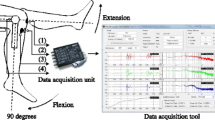Abstract
We address the problem of knee pathology assessment by using screw theory to describe the knee motion and by using the screw representation of the motion as an input to a machine learning classifier. The flexions of knees with different pathologies are tracked using an optical tracking system. The instantaneous screw parameters which describe the transformation of the tibia with respect to the femur in each two successive observation is represented as the instantaneous screw axis of the motion given in its Plücker line coordinates along with its corresponding pitch. The set of instantaneous screw parameters associated with a particular knee with a given pathology is then identified and clustered in R 6 to form a “signature” of the motion for the given pathology. Sawbones model and two cadaver knees with different pathologies were tracked, and the resulting screws were used to train a classifier system. The system was then tested successfully with new, never-trained-before data. The classifier demonstrated a very high success rate in identifying the knee pathology.














Similar content being viewed by others
Notes
For femur: mechanical axis refers to the line drawn from the center of the femoral head to the medial tibial spine; for tibia: mechanical axis refers to the angle formed by a line drawn from the medial tibial spine and the center of the ankle joint.
See discussion on registration and registration free procedure in the conclusion
References
Andriacchi T P, Alexander E J., et al. (1998) A point cluster method for in vivo motion analysis: applied to a study of knee kinematics. J Biomech Eng 120(6):743–749
Ball RS (1900) A treatise on the theory of screws. Cambridge University Press Cambridge
Begg R, Kamruzzaman J (2005) A machine learning approach for automated recognition of movement patterns using basic, kinetic and kinematic gait data. J Biomech 38:401–408
Blankevoort L, Huiskes R, et al. (1990) Helical axes of passive knee joint motions. J Biomech 23(12):1219
Bottlang M, Marsh JL, et al. (1998) Factors influencing accuracy of screw displacement axis detection with a D.C.-based electromagnetic tracking system. J Biomech Eng Trans ASME 120(3):431
Burges CJC (1998) A tutorial on support vector machines for pattern recognition. Data Mining Knowl Disc 2(2):121–167
Caruntu DI, Hefzy MS (2004) 3-D anatomically based dynamic modeling of the human knee to include tibio-femoral and patello-femoral joints. J Biomech Eng 126(1):44–53
Davidson JK, Hunt KH (2004) Robots and screw theory: applications of kinematics and statics to robotics. Oxford University Press, New York
DiGioia AB, Jaramaz J, et al. (2000) Surgical navigation for total hip replacement with the use of Hipnav. Oper Techn Orthop 10(1):3–8
Duck TR, Ferreira LM, et al. (2004) Assessment of screw displacement axis accuracy and repeatability for joint kinematic description using an electromagnetic tracking device. J Biomech 37(1):163
Fernandez JW, Hunter P J (2005) An anatomically based patient-specific finite element model of patella articulation: towards a diagnostic tool. Biomech Model Mechanobiol 4(1):20–38
Hart R, Mote C J, et al. (1991) A finite helical axis as a landmark for kinematic reference of the knee. J Biomech Eng 113(2):215–222
Hasan SS, Hurwitz DE, et al. (1998) Dynamic evaluation of knee instability during gait in anterior cruciate ligament deficient patients. Trans Orthop Res Soc 44:805
Hefzy MS, Ebraheim N, Mekhail A, Caruntu D, Lin H, Yeasting R, (2003) Kinematics of the human pelvis following open book injury. Med Eng Phys 25(4):259–274
Hunt KH (1978) Kinematic geometry of mechanisms. Clarendon, Oxford
Jonsson H, Karrholm J (1994) Three-dimensional knee joint movements during a step-up: evaluation after anterior cruciate ligament rupture. J Orthop Res 12(6):769–779
Maki B (1997) Gait changes in older adults: predictors of falls or indicators of fear? J Am Geriatr Soc 45:313–320
Pottmann H, Wallner J (2001) Computational line geometry. Springer, Berlin
Roth B (1984) Screws, motors, and wrenches that cannot be bought in a hardware store. MIT Press, Cambridge
Scholten R J, Opstelten W, et al. (2003) Accuracy of physical diagnostic tests for assessing ruptures of the anterior cruciate ligament: a meta-analysis. J Fam Pract
Shiavi R, Limbird T, et al. (1987) Helical motion analysis of the knee—I. Methodology for studying kinematics during locomotion. J Biomech 20:459–469
Soudan K, Van Audekercke R, Martens M (1979) Methods, difficulties and inaccuracies in the study of human joint kinematics and pathokinematics by the instant axis concept. Example: the knee joint. J Biomech 12:27–33
Vapnik VN (1995) The nature of statistical learning theory. Springer, New York
Vapnik VN (1998) Statistical learning theory. Wiley, New York
Woltring HJ, Huiskes R, et al. (1985) Finite centroid and helical axis estimation from noisy landmark measurements in the study of human joint kinematics. J Biomech 185:379–389
Acknowledgment
This work has been supported by NSF ITR grant IIS-0325920.
Author information
Authors and Affiliations
Corresponding author
Rights and permissions
About this article
Cite this article
Wolf, A., Degani, A. Recognizing knee pathologies by classifying instantaneous screws of the six degrees-of-freedom knee motion. Med Bio Eng Comput 45, 475–482 (2007). https://doi.org/10.1007/s11517-007-0174-1
Received:
Accepted:
Published:
Issue Date:
DOI: https://doi.org/10.1007/s11517-007-0174-1




